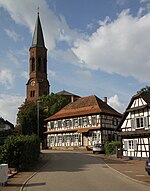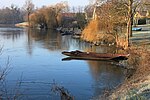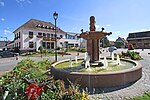Battle of Diersheim (1797)

The Battle of Diersheim (20–21 April 1797) saw a First French Republic army led by Jean Victor Marie Moreau clash with a Habsburg army commanded by Anton Count Sztáray de Nagy-Mihaly. Though both sides suffered about 3,000 killed or wounded in the bitter fighting, the Austrians finally retreated with the loss of 2,000 prisooners and 13 artillery pieces. Austrian General Wilhelm von Immens was killed and Sztáray badly wounded. The combat at Diersheim was a waste of lives because Napoleon Bonaparte signed the Preliminaries of Leoben with Austria a few days earlier, calling for a truce. However, Moreau's reputation was enhanced by his hard-won victory which occurred during the War of the First Coalition, part of the French Revolutionary Wars. Diersheim is one of a number of villages that make up the municipality of Rheinau. Diersheim lies one kilometer southwest of the Rhine River and about 9 kilometres (5.6 mi) northeast of Kehl.
Excerpt from the Wikipedia article Battle of Diersheim (1797) (License: CC BY-SA 3.0, Authors, Images).Battle of Diersheim (1797)
An den Fischteichen,
Geographical coordinates (GPS) Address Nearby Places Show on map
Geographical coordinates (GPS)
| Latitude | Longitude |
|---|---|
| N 48.65 ° | E 7.8833333333333 ° |
Address
An den Fischteichen
An den Fischteichen
77866
Baden-Württemberg, Germany
Open on Google Maps









